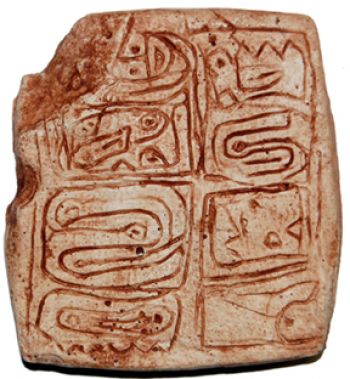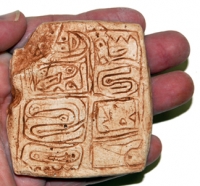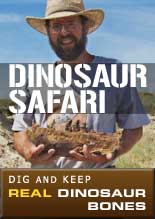
This is a direct casting replica of an Adena tablet, known as the Lakin tablet found at Point Pleasant, West Virginia. The tablet was found by Everette W. Schwartz.
The Adena culture was a Pre-Columbian Native American culture that existed from 1000 BC to 200 BC, in a time known as the early Woodland Period. The Adena culture refers to what were probably a number of related Native American societies sharing a burial complex and ceremonial system. The Adena lived in a variety of locations, including: Ohio, Indiana, West Virginia, Kentucky, and parts of Pennsylvania and New York.
STONE TABLETS
The Adena people carved small stone tablets, usually 4 or 5 inches by 3 or 4 inches by .5 inches thick. On one or both flat sides were gracefully composed stylized zoomorphs or curvilinear geometric designs in deep relief. Paint has been found on some Adena tablets, leading archaeologists to propose that these stone tablets were probably used to stamp designs on cloth or animal hides, or onto their own bodies. It's possible they were used to outline designs for tattooing.
Adena culture's most lasting artifacts were substantial earthworks. Adena sites are concentrated in a relatively small area - maybe 300 sites in the central Ohio Valley, with perhaps another 200 scattered throughout Indiana, Kentucky, West Virginia and Pennsylvania. Once Adena mounds numbered in the hundreds, but only a number of Adena earthen monuments still survive today. These mounds generally ranged in size from 20 to 300 feet (91 m) in diameter and served as burial structures, ceremonial sites, historical markers and possibly gathering places. These mounds were built using hundreds of thousands of baskets full of specially selected and graded earth. According to archaeological investigations, Adena mounds were usually built as part of burial ritual, in which the earth of the mound was piled immediately atop a burned mortuary building. These mortuary buildings were intended to keep and maintain the dead until their final burial was performed. Before the construction of the mounds, some utilitarian and grave goods would be placed on the floor of the structure, which was burned with the goods and honored dead within. The mound would then be constructed, and often a new mortuary structure would be placed atop the new mound. After a series of repetitions, mound/mortuary/mound/mortuary, a quite prominent earthwork would remain. In the later Adena period, circular ridges of unknown function were sometimes constructed around the burial mounds.
From, http://en.wikipedia.org/wiki/Adena_culture
resin
3 x 2.75 inches
Item 1384
Category: Replicas
Class: Hominids & Humans
MORE PHOTOS:


Now Over 1,000 Items!
PrehistoricStore.com offers the largest selection of replica fossils and other fossil-related products anywhere in the world!
Download a Full Catalog (3MB PDF)
OVER 260 PAGES OF REPLICAS AND MORE!
